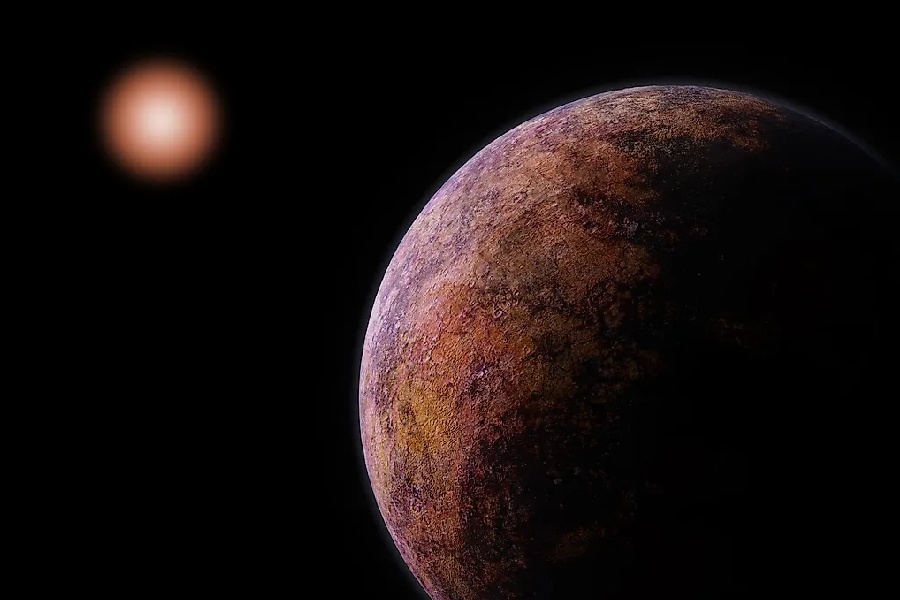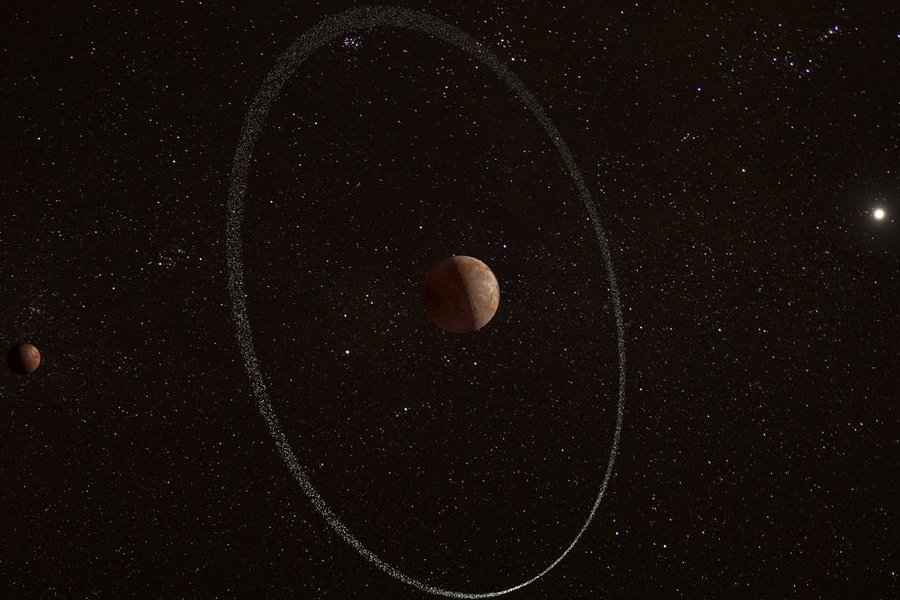Far beyond Neptune in the cold Kuiper Belt orbits an icy world. This mysterious world is known as Makemake. It is a minor planet that traces a wide, lonely path through the outer limits of our solar system. So, what is Makemake, and what makes it outshine its dark neighbors in the frigid Kuiper Belt?
Why does this icy orb exhibit such curious properties, unlike comparable dwarf planets? This article will explore emerging details about Makemake that set it apart, from its unexpected brightness to theories about its atmosphere and origins.
Let’s get started!

What Is Makemake?
Makemake was designated the third biggest Kuiper Belt Object in 2008, but it took nearly a decade for astronomers to see it properly for the first time. This long-awaited close-up revealed a surprise. Its surface lacked the reddish dust expected of similar frozen worlds.
But is Makemake a planet? Makemake is a dwarf planet in the Kuiper Belt, discovered in 2005. Classified by the IAU in 2008, it’s one of the largest Kuiper Belt objects, about two-thirds the diameter of Pluto.
Named after Easter Island’s creator deity, it lacks a significant atmosphere and likely has an icy surface with tholins. So, Makemake’s discovery enhances our understanding of the outer solar system.
Discovery in the Outer Solar System
Origins in mythology
Makemake holds the distinction of being one of the most recently discovered officially recognized dwarf planets, spotted for the first time only 16 years ago. Its designation references an important figure from the mythological traditions of Easter Island—fitting for a distant world evoking mystery.
Unexpected Glimpse in 2005
Makemake was discovered in 2005 by astronomers doing wide-field surveys. It shined brightly but moved slowly, demonstrating its enormous distance.
Also, further tracking established its extreme orbit even beyond Pluto, taking over 300 years to circle the Sun. Its brightness and size led to Makemake’s classification as the third-largest Kuiper Belt object.
Interpreting Makemake’s designation
Assigning an official name
In accordance with astronomical naming practices, the discovery team proposed the name Makemake after a Polynesian deity. This Easter Island native god of fertility and creator of humanity seemed apt for such a groundbreaking discovery praising Newfrontiers.
Cementing Makemake in history
The naming nods to Makemake’s Pacific origins in the same region first inhabited by the Rapanui people who worshiped that god. Now immortalized in astronomy, the name Makemake will be forever cemented to this icy world just as the legends persist on Earth.
Makemake’s Physical Characteristics
An icy dwarf planet
Dimensions and structure
Although dwarfed by planets, Makemake ranks among the largest denizens of the Kuiper Belt. But how big is Makemake? Careful measurements reveal its diameter spans about 870 miles – nearly as wide as Pluto.
Hence, its size classifies Makemake as a dwarf planet. Models propose a frozen, porous inner structure divided into a rocky core and an ice mantle.
Surface composition
Makemake’s surface dazzles with ultra-bright iced-over highlands stretching for miles. Spectroscopic light signatures reveal the main component as frozen methane, playing a key role in the puzzling albedo extremes.
Moreover, numerous complex organic compounds mix with the ice in varied concentrations, hinting at possible atmosphere sources. The distribution holds insights into Makemake’s origins and subsurface heat flows.
A puzzling bright surface
Unexpectedly sparse dark terrain
Given the prevalence of darker material called tholins on comparable Kuiper Belt worlds, scientists expected Makemake to exhibit significantly more patches of reddish carbon-rich molecules.
However, high-resolution imagery found limited darker terrain, making the surface over a third more reflective than Pluto’s What drives this stark divergence from its neighbors remains unknown.

Makemake’s Orbit and Location
Orbital characteristics
Makemake, a distant dwarf planet in our solar system, follows an elliptical orbit with unique characteristics. But how far is Makemake from the Sun? Its semi-major axis, the average distance from the Sun, is approximately 6.85 billion miles (11.06 billion kilometers).
This places Makemake in the outer reaches of the solar system, contributing to its frigid environment. The orbital eccentricity, a measure of orbit’s deviation from a perfect circle, plays a role in Makemake’s seasonal variations and extreme temperature fluctuations.
Position in the Kuiper Belt
Makemake resides within the Kuiper Belt, a vast region beyond Neptune populated with small, icy bodies. Positioned among other Kuiper Belt objects (KBOs), Makemake’s location holds key insights into the formation and dynamics of this distant realm.
So, studying its orbital interactions with neighboring objects provides valuable data. This data enhances our understanding of the Kuiper Belt’s structure and the primordial remnants of our solar system.
Comparative Analysis With Other Dwarf Planets
Contrasting features with Pluto
In a comparative analysis with Pluto, one of the most renowned dwarf planets, Makemake exhibits notable differences. Unlike Pluto, Makemake lacks a significant atmosphere, which affects its surface dynamics.
Additionally, Makemake’s size and composition vary, contributing to distinctions in their overall characteristics. Understanding these differences enhances our comprehension of the diverse nature of dwarf planets within the Kuiper Belt.
Similarities with other Kuiper Belt objects
Makemake shares characteristics with other Kuiper Belt objects, forming a class of icy bodies that bear witness to the solar system’s early stages. Its composition, predominantly composed of ices such as methane and ethane, aligns with common features found among Kuiper Belt objects.
Hence, exploring these similarities sheds light on the shared origin and evolution of these distant inhabitants. This unravels the mysteries of the outer solar system.
Glimpsing a Transient Atmosphere
Possible composition and drivers
Though often called atmosphere-less, emerging evidence suggests Makemake might exhibit a temporary atmosphere. This occurs primarily during parts of its orbit when nearing perihelion.
However, any temporary atmosphere is most likely made up of nitrogen, methane, and ethane ices that are sublimating when noon peak temperatures hit -220 degrees Fahrenheit.
This highlights the importance of an orbital context.
Constraints from telescopic studies
Attempts to see such an atmosphere through star occultation have provided fascinating but thus yet inconclusive suggestions of a thin, patchy shrouding.
Nonetheless, further observations are vital to decisively determining whether Makemake exhibits a recurring atmosphere.
Chasing an Elusive World
Past and proposed flyby missions
As one of the largest known classical Kuiper Belt objects, Makemake seems a natural target for detailed robotic exploration. Yet, no past or funded missions currently target investigating Makemake directly.
Only New Horizons long-range observations exist. Multiple proposed concepts suggest harnessing advanced ion drive technologies to reach Makemake within a couple of decades.
The challenges of reaching 100 AU
The extreme distances and orbital times for Makemake and its neighbor dwarf planets pose steep challenges. However, it took New Horizons 15 years before it eventually encountered Pluto.
Therefore, making the leap to worlds even more distant and slowly orbiting requires next-level propulsion investments. It likely involves multiple spacecraft working cooperatively to study this region.
Conclusion
What is Makemake? Learning about the alien nature of this distant icy dwarf planet pushes our current understanding. We explored details about its unexpectedly bright terrain, transient atmosphere, and orbit sculpting nearby Kuiper Belt objects. We also discussed other properties distinguishing Makemake from its neighboring minor planets.
New observations and proposed exploratory missions await propulsion technologies. They can explore these slow-orbiting, barely-glimpsed planets further than ever in our stellar backyard.
Altogether, we hope your insight on Makemake, the Kuiper Belt region, and the enduring quest to prove our cosmic neighborhood’s boundaries has expanded. We believe it has left you eager to track the next revelations sure to come.
